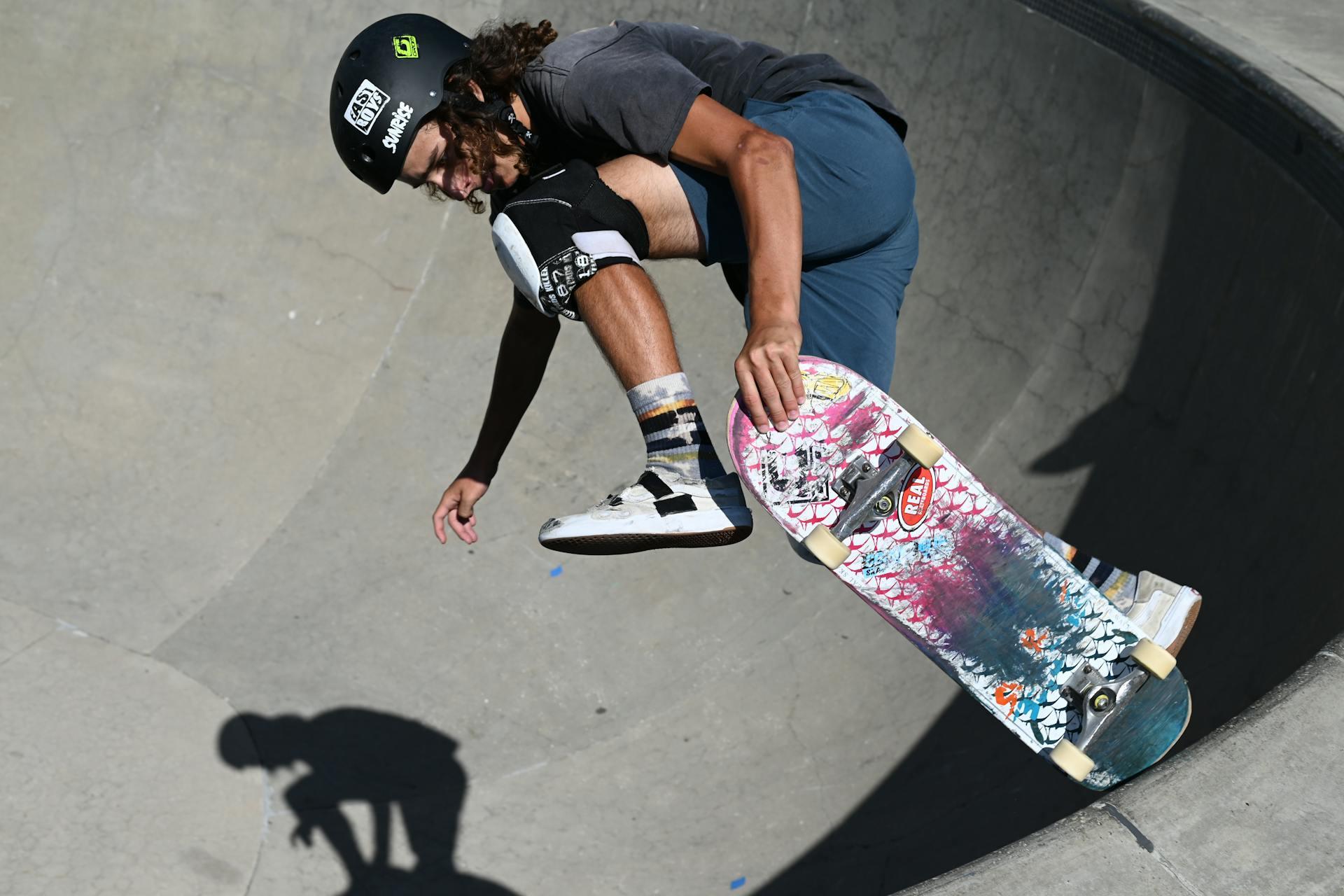Skateboarding has become a more mainstream activity over the years, which is exciting for the skating community who is always happy to include more enthusiastic skaters! However, that means that spreading awareness about skateboarding safety is more important than ever as more and more people start learning how to skate.
Skateboarding is a fun and exciting hobby and sport, but it comes with many inherent risks. To ensure you learn how to ride a skateboard without hurting yourself, make sure you read articles (like this one!) to get familiar with safety. Whether you’re about to step foot on a board for the first time or have been ripping up the half-pipe for years, having the right safety equipment and knowledge is equally important for all skaters.
Find out what skateboard accessories for beginners and practices you should pick up to stay safe and keep having fun!

Number One Piece of Skate Gear: Skateboard Helmet
Wearing a helmet during any sport or activity with a fall risk is imperative. Since skateboarding is always on very hard surfaces like concrete and asphalt, with the added risks of low metal bars and other protruding objects around, you simply should not ever get on a skateboard without a helmet.
Head (brain) and facial injuries, including concussions and fractures, are very common among skateboarders and can be devastating when they happen without a helmet. Avoid damage from big injuries or repetitive smaller ones (like multiple mild concussions) by wearing a helmet.
Many skate parks mandate the use of helmets, reflecting how important they are for the safety of skaters of all levels.
Choosing the Right Helmet
Your skateboard helmet should meet the safety standards set by the CPSC and be designed specifically for skateboarding. Bike helmets are not designed for the types of falls that skateboarders experience, so while they’re better than nothing, they may fail to protect the back of the head in case of a backward fall.
Finding the Proper Fit
Your helmet must also be the correct size and the straps must be tightened to the correct level. You can ask someone at your local sports equipment shop to help you or look at videos online of how to find the right fit.
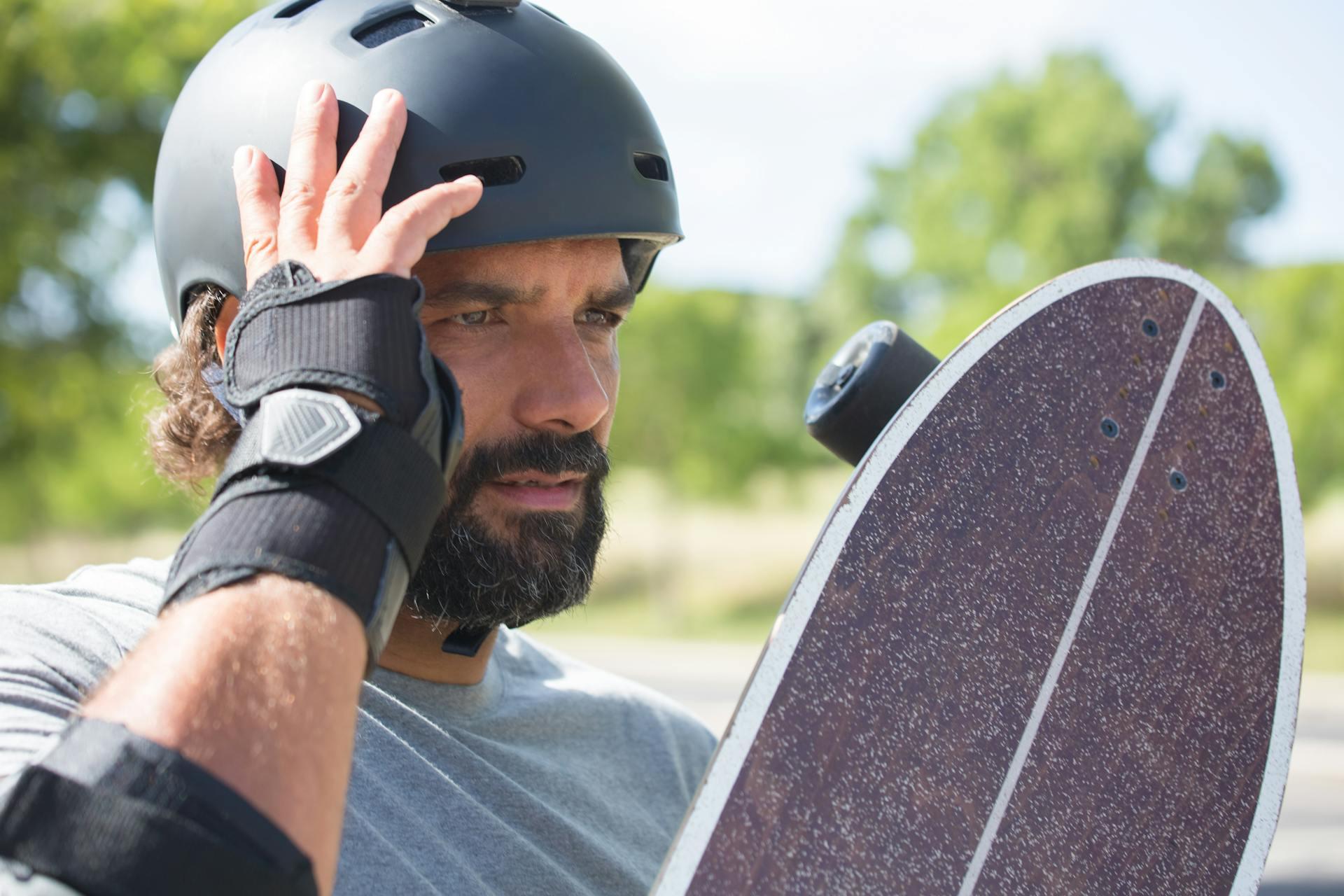
Generally, a properly fitting helmet sits snugly on top of the head, protecting both the back of the head and the forehead. It does not fall forward and block your vision or fall backward and expose the forehead. You can measure your head and consult the helmet brand’s sizing chart to find a good fit, too.
Protective Pads Are a Must
Skateboarding involves lots of risks, so protective pads are essential to reduce injury during falls. Protective pads help absorb shock from falls and reduce the risk of broken bones. They also protect against scrapes and cuts. Nobody wants to ruin their fun day of skateboarding with road rash all over their arms! Wearing knee pads, elbow pads, and wrist guards is a must when skating, especially for beginners.

Different Types of Pads
Knee and elbow pads should always be made of a non-chafing material on the inside with a hard plastic outside.
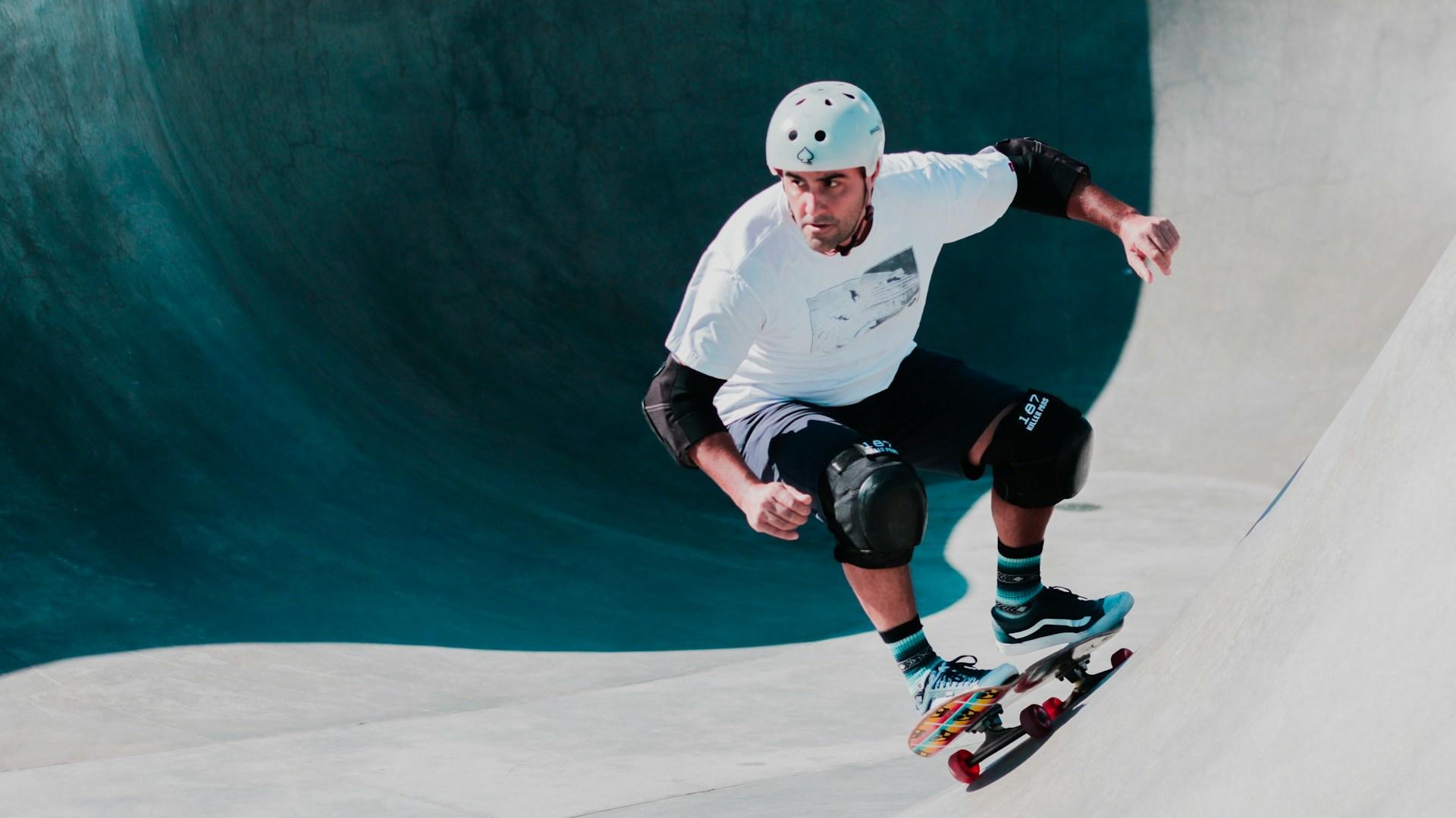
More advanced skaters might be able to wear soft pads that help prevent scrapes without the hard plastic casing, but that’s only because they have a lot of experience mitigating damage when falling down. As a beginner, you should definitely use hard knee and elbow pads.
Wrist guards aren’t that good at preventing fractures simply because of the location and structure of the wrist. But, they’re excellent for preventing cuts and scrapes. As a beginner, you can expect to fall on your hands a lot, so wearing wrist guards will save you a lot of pain and bandages.
Guidelines for Selecting the Right Pads
Choosing the right pads involves considering your skateboarding style and the level of risk involved. Measure your knee, elbow, and wrist to ensure a snug fit that doesn't restrict movement. Many brands will have a size chart to refer to for your measurements.
You can also buy additional under-pad gaskets if you are having chafing problems with your pads.
Always opt for pads that offer a balance between comfort and protection to maintain performance while staying safe.
Fasten the pads tight enough that they don’t move out of place, but not so tight that you can’t move properly.
Choosing the Right Skate Shoes
Proper skateboard shoes provide essential grip while allowing you to “feel” the board, so you always know where your feet and toes are on the deck. Additionally, skate shoes are designed to protect against common injuries by providing shock absorption, a streamlined shape to avoid getting caught on things, and being rugged enough to survive scraping against the grip tape and ground a lot.
Features to Look For
When choosing skate shoes, consider the sole type—vulcanized for flexibility and board feel, or cupsoles for better impact protection and durability.
Materials like suede, leather, or canvas affect the shoe's longevity and performance, with options like toe caps and padded collars adding extra protection and comfort. Also, look for shoes that offer a good balance of cushioning and board feel to suit your skating style.
High-top shoes can be great for ankle support, but some people find them uncomfortable and would rather choose a lower-top style. Try on many different shoes in the store to find out which ones feel the most comfortable and supportive.
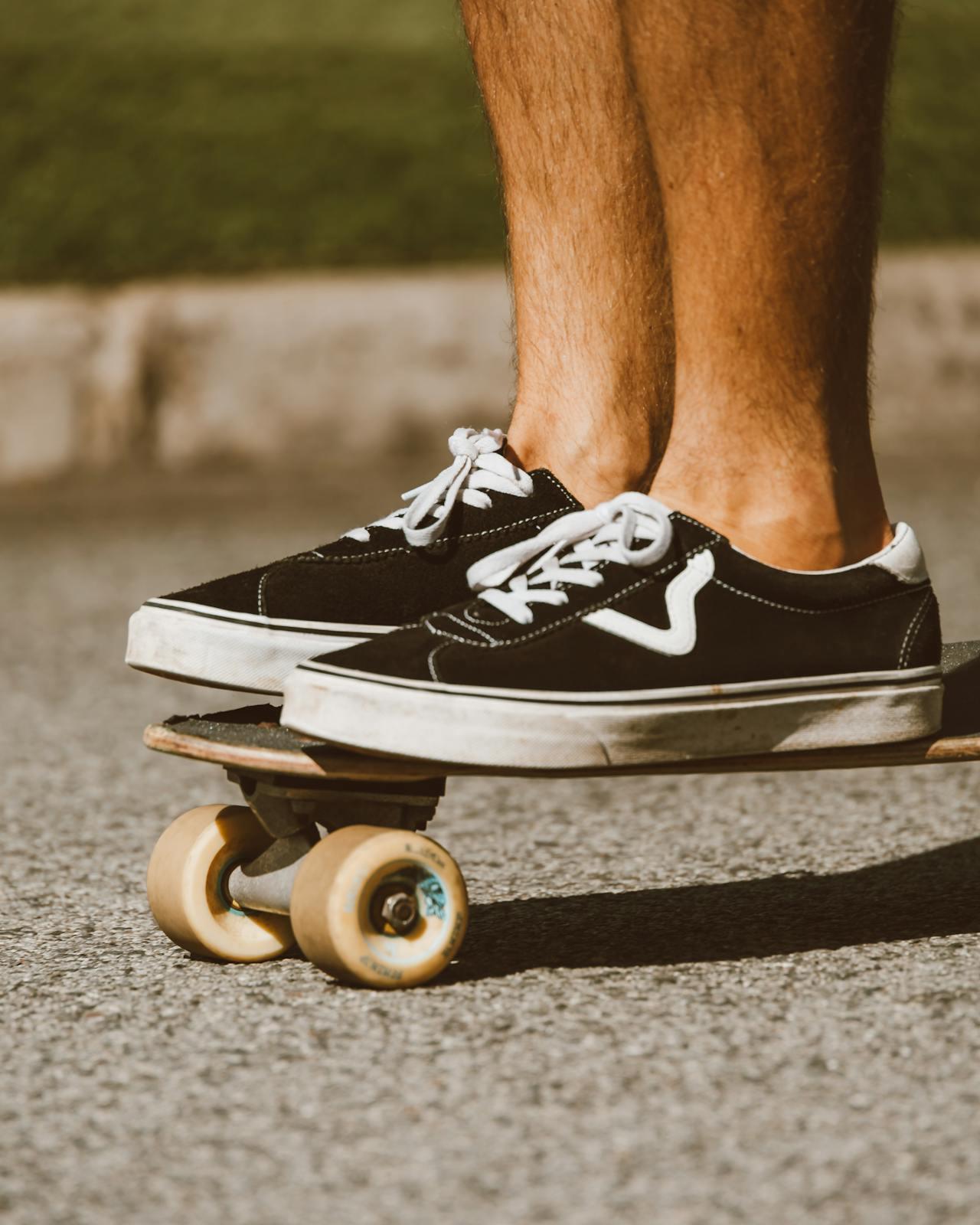
Make sure your laces are never dragging - they’ll get caught in your wheels and cause you to wipe out!
Popular Brands for Skateboarding Shoes
Some of the most popular brands of skate shoes are:
- Vans
- Airwalk
- Etnies
- Converse
- Adidas
- New Balance
- Nike
Some people like to use Converse Chuck Taylor shoes, even though they are designed for basketball, not skateboarding.
Best Skateboard Brands
Every skateboard on the market is suitable for skating; skateboarders are very practical! But, what brands and styles are the best for beginners?
8” is typically a great size for new riders to learn on, regardless of their age, size, and stature. Some smaller people might feel more comfortable with a junior-sized board instead, however.
Make sure your board
- Is made of plywood (not plastic)
- Has metal trucks (not plastic) that learn
- Has polyurethane wheels (not hard plastic or rubber) that measure between 90A and 100A
Here are some of the best brands that have beginner skateboards:
- Birdhouse
- Santa Cruz
- CCS
- SkateXS
- Arbor
- Element
- Globe
- Enjoi
- Tony Hawk
- Alien Workshop
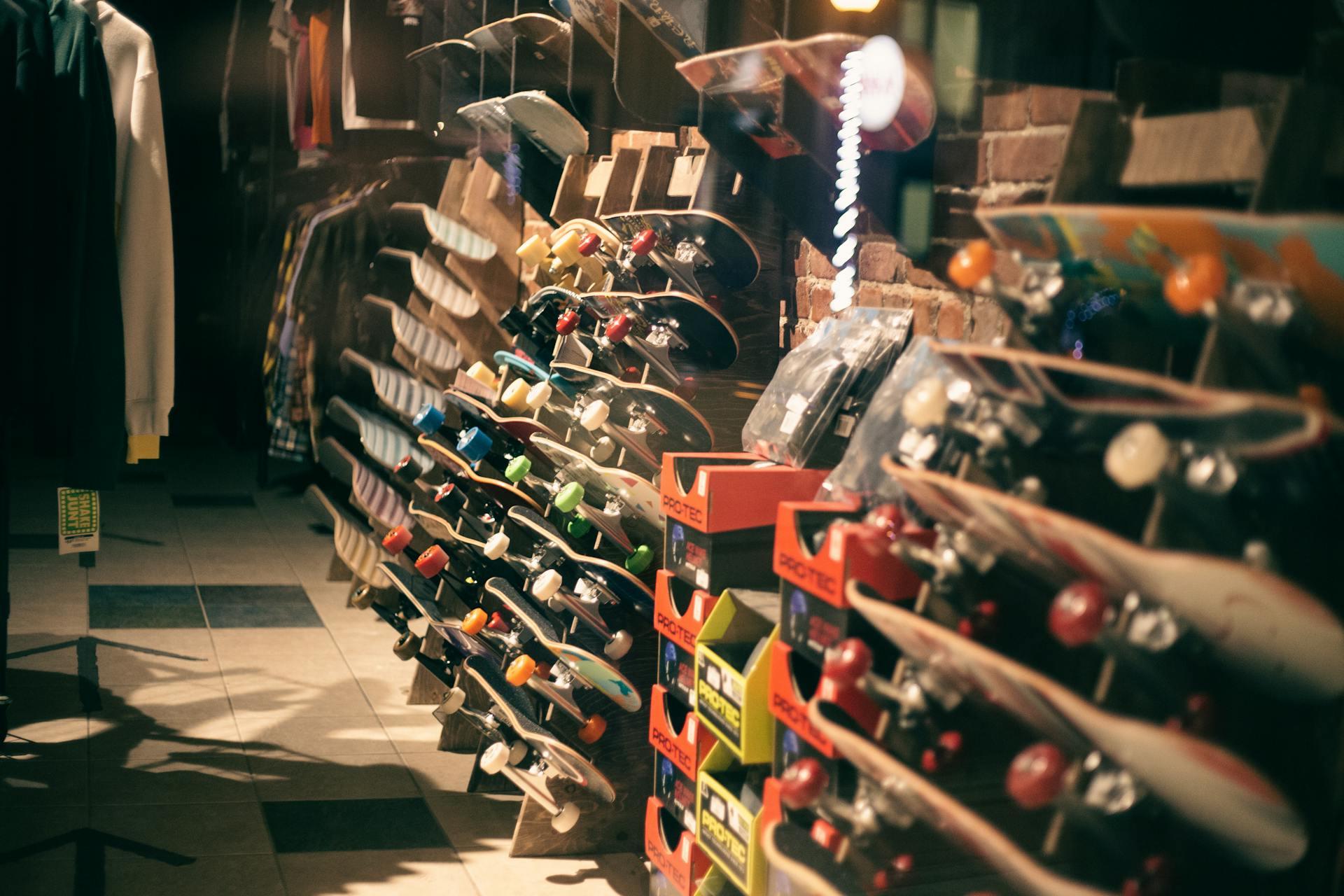
Additional Skate Equipment
If you’ve got a helmet, pads and guards, and decent shoes, you are ready to skate. However, you can make your skateboarding more enjoyable, comfortable, and even safer with some other equipment as well.
Goggles and Glasses
You might not consider eye protection as essential skate safety equipment, but it is possible to hit your face while skating! So, protecting your eyes is a great idea. Plus, they can keep dirt and debris out of your eyes at all times.
Consider specialized goggles or glasses with polycarbonate lenses. These lenses are not only impact- and shatter-resistant but also provide UV protection.
Clothing and Accessories
Skateboarding is a pretty casual sport in terms of clothes. You can wear almost anything! But, especially for beginners, it’s important to be very mindful of how well your clothes can protect you or hinder you.
Avoid loose and baggy clothing that can obscure your view of your feet and board, or worse, get caught in the wheels. Denim jeans and long sleeves are a good choice to help protect your legs and arms from road rash. If you’re out in the sun, clothes that help block the rays are also a good idea so you feel cooler and reduce your risk of sunburn (also, wear SPF!).
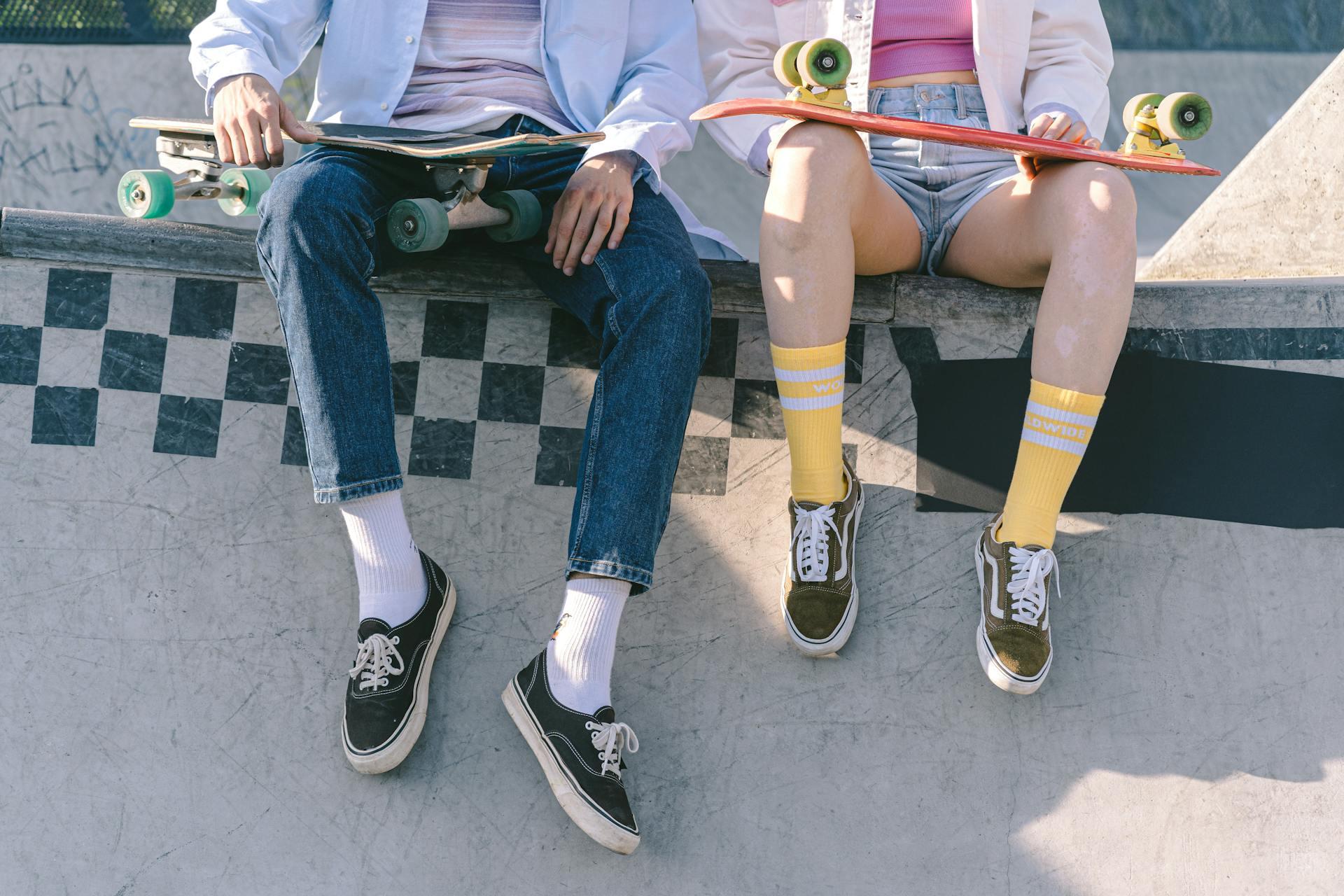
Avoid wearing jewelry and accessories that dangle, and make sure your shoelaces are tight and secure.
Other than those guidelines, you can wear pretty much whatever you want! As you get more confident, you can even start wearing things like shorts, skirts and tutus, tank tops, and other fashionable choices because you’re less likely to fall and need added protection from your clothing.
You can stash all your skateboarding equipment in a dedicated skateboard backpack that suits your personal style!
Best Practices for Skateboard Safety
Safety gear is only one facet of skateboarding safety. You also need to make sure you and your skateboard gear are in good working order before each skating session. Your safety is only as strong as your weakest link!
Inspecting Your Skateboard
Always ensure your skateboard is in optimal condition before riding. Check for loose, broken, or cracked parts and ensure the wheels are free from nicks, cracks, and debris.
Inspect the trucks and make sure they’re in good shape and well-fastened to the board.
Inspect your skateboard deck and ensure the grip tape still has integrity. If it’s too worn down, be sure to replace the skateboard grip tape on your deck with new tape.
Every once in a while, cleaning your wheels is a good idea to make sure they last longer and don't break or lock up while you're riding. Remove the wheels from the trucks, remove the bearings, and soak the wheels in soapy water for a few minutes. Scrub them clean, rinse, and then let them air dry completely before putting them back together.
Inspecting Your Skateboarding Gear
Check your helmet, pads, and guards for holes and cracks. A cracked helmet must be replaced since the structural integrity is compromised, which means that it will not do as good of a job protecting you if you fall.
This is why construction workers must always inspect their helmets as well, and many places don’t allow stickers on helmets since they can obscure damage. If you put stickers on your helmet, just be aware that it might cause a crack to go unnoticed!
Additionally, make sure all your gear is free from things like sticks, rocks, bugs, and other debris that might compromise their performance.
Learning How to Fall
Falling correctly can significantly reduce the risk of serious injuries. Practice falling techniques like crouching down to reduce the fall distance and aiming to land on fleshy parts of your body. Learning to roll during a fall and relaxing your body can also minimize impact.
General Safety Tips
Adhere to local skateboarding laws, never skateboard in the street, and avoid crowded or uneven surfaces. Always wear a helmet and appropriate protective gear. It's also crucial to avoid skateboarding under the influence of substances or in wet conditions to prevent accidents.
Avoid wearing headphones, especially at a skate park, so you can hear your surroundings and react to situations.
Finally, limber up a little bit before your skate sesh by doing some simple stretches. If you have an existing injury or feel weak, don’t get on your board! You risk making your injury worse, getting hurt because you can’t move the right way fast enough, or passing out while riding!
Learning how to skateboard is a fun, rewarding, and exciting adventure. Ensuring that you have all the necessary skateboard safety equipment means you can fall down again and again without fear. Part of learning how to skate is falling down and getting back up more times than you can count, but you can avoid devastating injuries with your helmet, pads, and guards. Maintaining your equipment is also a good habit to learn early on so you can acquaint yourself with your tools and be in harmony with your instrument – your skateboard.
Gear up with confidence so you can start learning all the cool skateboard tricks and more that you want to master!

